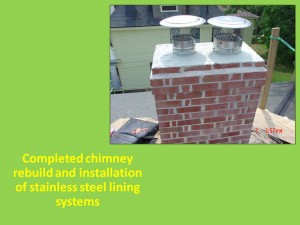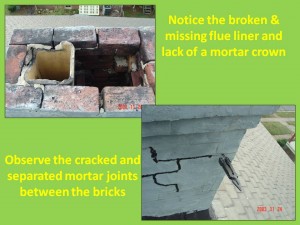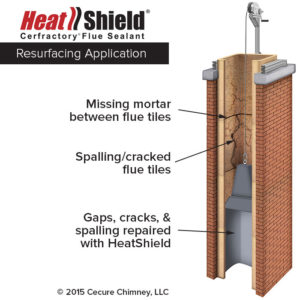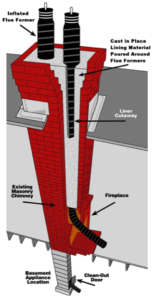

Do you have a fireplace in your home that you use, even infrequently? Does your furnace, boiler, or water heater use a chimney? Have you recently purchased a house and want to use your fireplace, but you aren’t sure if it is up to code? Are you curious about the anatomy of this important part of your home? If you answered yes to any of these questions, then you need to know all about chimney liners! Chimney liners are a crucial part of your chimney system, and making sure yours is up to regulation is crucial for safety. Burning fuel with a damaged liner runs the risk of exposure to dangerous fumes or even house fires. Read on to understand how chimney liners work and how to ensure that they are in good shape to keep your home safe.
What Does a Chimney Liner Do?
A chimney liner, or a flue liner, is one of the most important parts of your chimney system. While the outside of your chimney is likely made from either brick and mortar or covered in siding, the inside of the chimney should be a smooth passage made of the right material to contain the smoke, heat, and carbon monoxide from the fires as they travel up your chimney. If you were to look down the top of your chimney, this may look like a smaller interior pipe made of metal or clay that sits inside of the outer structure.
The liner within the chimney creates a barrier and blocks the gases and heat from coming into direct contact with the brick itself. This double-walled system protects your home from chimney fires as these liners channel the heat and gases up to the chimney top and keep any combustible material around your chimney from catching fire. It is important for the smoke and heat to have a clear exit out and away from your home. According to the National Bureau of Standards, the material in the lining, insulation, and walls surrounding a chimney can ignite in under four hours if no proper chimney liner is present.
What Materials are Chimney Liners Made Of?
Chimney liners or flue liners can be made of different materials, but will all have some properties in common. They need to be able to contain the heat and gases that are released when fuel is burned, they need to be whole and undamaged to make sure that no smoke escapes before it reaches the top of the chimney, and they need to be resistant to any buildup of soot, moisture, or creosote, which are acidic and corrosive to masonry.
The main types of chimney liners are metal, clay tile, and cast-in-place liners. They all have different properties and advantages, and one may be a better solution for your chimney than another. Read on to learn more about each kind of liner and which may be best for your home!
Clay Tile Liners
Clay tile liners are what most people think of when they imagine the traditional chimney flue liner. Commonly made from Terra Cotta and mortared together in sections, these liners have traditionally been the most affordable and easy to install option. These tiles are made to withstand high heat and have been specially smoothed on the inside to make sure that there are no cracks or rough spots where soot can build up more rapidly than normal.
If properly installed, most homeowners can expect the life of the clay tile liners to last more than 50 years. However, regular cleanings and inspections are critical as these tiles and the mortar joints between them will deteriorate over time. If the mortar joints between your clay tiles become compromised, carbon monoxide can leak into the home. In the case of a wood-burning fireplace, flammable creosote can travel out of the open joints into areas where it cannot be removed. It’s recommended to have your chimney inspected for any cracks, gaps, voids, or construction defects if you have clay tile liners. Any gaps in the chimney liner can result in the heat reaching combustible materials, which can cause a house fire.
Metal Chimney Liners
Metal liners, specifically stainless-steel liners, are recommended the most by installers and fire-protection experts. They recommend this type of liner because the liners typically come with a lifetime warranty and can handle the exhaust products from gas, pellet, and oil combustion as well as wood-burning. These look like a metal pipe, often corrugated and flexible, that is inserted down your chimney to provide a whole and unbroken passage for the fireplace or furnace to exhaust through. Stainless steel is the best material for a metal liner due to its durability and availability in flexible formats to navigate any chimney. Although the cost of this material plus the installation is expensive, it is an excellent investment and will need fewer repairs over the lifetime of the product.
Cast-In-Place Liners
A final option for chimney liners is called a “cast in place” liner. This is a process involving poured “cement” to create a new chimney liner, often with the help of a mold. This type of liner is strong enough to withstand all the harmful effects of any condensation, heat, or acids, and provide excellent insulating properties. However, the process to install this kind of liner is much more intensive and often an expensive venture, and we generally recommend a stainless steel liner for most households.
The Hazards of Having a Damaged Chimney Liner
Why is it so important to make sure that your flue liner is “the right stuff” and in good shape? Besides the risk of your house catching on fire, a damaged chimney liner can also impose serious health risks to you and your family. An undamaged flue liner prevents the escape of carbon monoxide, smoke, and other harmful gases into your home. If anyone in your household inhales these gases, it can lead to serious respiratory illnesses or death.
If the interior surface of your chimney liner is rough, cracked, or otherwise damaged, it provides surface area for soot and flammable creosote to build up and weak spots where moisture and acidic soot can exfiltrate and damage the masonry of your chimney. The soot and smoke given off by fires are acidic and will corrode brick, clay, and mortar over time, causing internal damage not visible from the outside of your home. These damaged spots are weak points that can progress into cracks, flaking tile or bricks, or even gaps in the liner that no longer prevent heat transfer from the flue into the flammable materials around your chimney.
The Importance of Professional Inspections
There are some obvious signs that your chimney has damage or needs repairs, such as condensation, visible cracks, or smoke streaks on the surrounding walls or ceilings. However, many types of damage, especially to the interior parts such as your chimney liner, will not be visible to the untrained eye and can cause significant damage before they become evident. At Black Goose Chimney we can provide three levels of inspection to ensure that even the smallest damage is caught before it becomes a bigger issue. You may not be able to see the deterioration as it begins, and if you don’t catch it early, you and your family may be exposed to harmful gases.
What Is Chimney Relining?
Chimney relining is when you install a specific type of material inside the chimney to ensure that your chimney continues to function correctly. The main reasons you will need to reline your chimney are if you have a damaged chimney liner or if you are installing a new fireplace, gas logs, or woodstove. The primary reason you would want to replace the liner after installing a new fireplace is that the new fireplace or heating stove may use a different fuel type or require a different vent size.
How Often Should You Reline Your Chimney?
Most stainless steel liners come with a manufacturer’s limited lifetime warranty. Terra cotta flue tiles can last fifty to one hundred years with proper care and maintenance. The National Fire Protection Association calls for having your chimney inspected once every year to ensure no cracks or other hidden damages. This inspection is critical regardless of the amount of use. It is similar to getting your car inspected once a year regardless of the mileage driven. There are things that will deteriorate with time, especially at the top of the chimney.
Which Chimney Liner Is Right for Your Home?
The type of fireplace you have determines the type of liner that you should use for your chimney. The type of fuel that you burn is also a contributing factor. Other factors that determine the type of liner you need are:
- Height of your chimney
- The type of fuel being burned
- The size of the fireplace
- The material used to build your fireplace
You should reach out to a professional to come and inspect your chimney to determine the best type of liner for your chimney. Choosing the correct size chimney liner is essential to ensure that your fireplace runs as it should. If your liner is undersized or oversized, the chimney will not vent the gases and heat properly.
Hire a Chimney Liner Professional
Knowing which chimney liner is best for your home is critical to ensure that your fireplace runs at its operational best. Although you may notice that your chimney liner has damage, it is always best to contact a professional to come to inspect and repair your chimney liner. A professional can properly assess the chimney and minimize the risk of any serious damage or respiratory health problems that can harm you and your loved ones. If you are looking for more information on chimney liners and the process of relining your chimney, contact us now.


